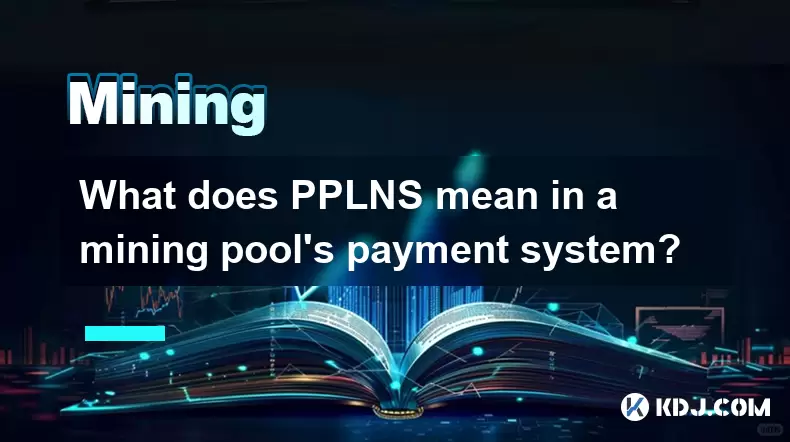-
 bitcoin
bitcoin $118548.520763 USD
3.67% -
 ethereum
ethereum $4352.564943 USD
4.79% -
 xrp
xrp $2.964058 USD
4.22% -
 tether
tether $1.000565 USD
0.05% -
 bnb
bnb $1028.372955 USD
1.46% -
 solana
solana $221.373507 USD
6.00% -
 usd-coin
usd-coin $0.999933 USD
0.02% -
 dogecoin
dogecoin $0.248633 USD
6.85% -
 tron
tron $0.341444 USD
2.38% -
 cardano
cardano $0.852946 USD
5.82% -
 hyperliquid
hyperliquid $47.869306 USD
6.15% -
 chainlink
chainlink $22.561476 USD
6.01% -
 ethena-usde
ethena-usde $1.001258 USD
0.05% -
 avalanche
avalanche $30.660000 USD
2.06% -
 stellar
stellar $0.400917 USD
9.76%
What does PPLNS mean in a mining pool's payment system?
PPLNS rewards miners based on the last N shares before a block is found, promoting steady participation and discouraging pool hopping.
Aug 12, 2025 at 01:56 am

Understanding the Basics of PPLNS in Cryptocurrency Mining
PPLNS stands for 'Pay Per Last N Shares', a widely used reward distribution method in cryptocurrency mining pools. Unlike other payment systems such as PPS (Pay Per Share) or PROP (Proportional), PPLNS focuses on rewarding miners based on their recent contribution to the pool’s overall work. The core idea is to incentivize consistent participation by calculating payouts according to the number of valid shares submitted during a specific window—specifically, the last N shares before a block is successfully mined.
In this system, when a block is found by the pool, the block reward (minus any fees) is distributed only to those miners whose shares fall within the defined last N shares. This means that if a miner submits shares sporadically or only during high-luck periods, they may receive smaller rewards compared to those who mine continuously. The value of N varies between pools and is often set based on average network difficulty and expected hash rate.
How PPLNS Calculates Miner Rewards
The calculation process in PPLNS relies on tracking the sequence of shares submitted by all participants leading up to a found block. Instead of resetting after each block, the pool looks back at the most recent N shares, which may span multiple block rounds. This creates a 'sliding window' of contribution measurement.
- Determine the total number of shares in the window, capped at N.
- Count how many of those shares were submitted by each individual miner.
- Allocate the block reward proportionally based on each miner’s share count within the window.
- If the number of shares before the block discovery is less than N, all shares from the current round are used, even if fewer than N.
For example, suppose N is set to 1,000,000 shares and a block is found after only 600,000 shares have been submitted in the current round. In this case, the entire 600,000 shares are used for distribution. However, if 1.5 million shares were submitted across multiple rounds, only the last 1 million would count.
This mechanism discourages 'pool hopping,' where miners jump between pools during low-difficulty or high-reward periods, because rewards depend on sustained contribution rather than momentary effort.
Differences Between PPLNS and Other Payment Methods
One major distinction between PPLNS and PPS (Pay Per Share) is risk distribution. In PPS, miners are paid a fixed amount for each valid share, regardless of whether the pool finds a block. This shifts the variance risk to the pool operator. In contrast, PPLNS passes the variance to the miner—payouts fluctuate depending on how frequently the pool finds blocks and how actively the miner contributes around those discoveries.
Compared to PROP (Proportional) systems, where rewards are distributed based on shares submitted during a single round (resetting after each block), PPLNS uses a rolling window. This means a miner who was active before a block is found—even if they weren’t mining during the final moments—can still receive a portion of the reward if their shares fall within the N-share window.
Another key difference lies in fairness over time. PPLNS rewards miners who maintain a steady hashrate, while systems like FPPS (Full Pay Per Share) include transaction fees in the payout model. PPLNS typically excludes transaction fees unless explicitly stated by the pool, focusing only on the base block reward.
Setting Up and Monitoring PPLNS Earnings in a Mining Pool
To effectively participate in a PPLNS-based mining pool, miners must configure their mining software correctly and understand how to interpret their dashboard statistics. Most pools provide real-time data on estimated payouts, share counts, and round progress.
- Choose a reputable mining pool that supports PPLNS (e.g., Slush Pool, F2Pool).
- Configure your mining software (such as CGMiner, BFGMiner, or EasyMiner) with the pool’s server address, port, and your wallet credentials.
- Monitor your 'round shares' and 'effective shares' in the pool’s web interface.
- Check the current value of N—this is often visible in the pool’s FAQ or stats page.
- Use the pool’s payout calculator to estimate earnings based on your average hash rate and recent pool performance.
It’s important to note that PPLNS introduces payout variance. Even with a stable hash rate, your daily income may fluctuate significantly depending on the pool’s luck in finding blocks. Some pools provide a 'luck graph' or historical data to help miners anticipate these swings.
Factors That Influence PPLNS Profitability
Several variables impact how much a miner earns under the PPLNS model. The most significant is pool hashrate stability. A larger, more consistent pool finds blocks more regularly, reducing the time between payouts and smoothing out income.
The miner’s consistency is equally critical. Because PPLNS evaluates the last N shares, miners who stop and restart frequently may miss inclusion in reward windows. Continuous mining increases the likelihood that a larger portion of their shares will fall within the payout range.
Network difficulty adjustments also affect PPLNS. When difficulty increases, it takes more computational effort to find a block, meaning more shares are submitted over time. This can dilute individual rewards if N remains fixed. Conversely, during difficulty drops, blocks may be found faster, potentially increasing payout frequency.
Lastly, the value of N itself plays a pivotal role. A higher N makes the system more forgiving to miners with intermittent connectivity, while a lower N emphasizes recent performance and punishes inactivity more harshly.
Frequently Asked Questions
What happens if I stop mining before a block is found?If your shares are within the last N shares before the block discovery, you will still receive a payout even if you’ve disconnected. However, if your shares fall outside this window, they won’t count toward the reward.
Can I increase my PPLNS earnings by switching pools frequently?No. PPLNS is designed to penalize pool hopping. Miners who switch pools often miss out on the tail end of share windows and fail to accumulate enough contributions to earn proportional rewards.
How do I know what N value my pool uses?Most pools display the N value in their statistics dashboard or FAQ section. For example, Slush Pool uses a dynamic N based on historical shares, while others like BTC.com use a fixed number such as 1,000,000.
Are transaction fees included in PPLNS payouts?Typically, no. Standard PPLNS only distributes the base block reward. Some pools offer a variant called PPLNS+ or include fees separately, but this must be explicitly stated in the pool’s policy.
Disclaimer:info@kdj.com
The information provided is not trading advice. kdj.com does not assume any responsibility for any investments made based on the information provided in this article. Cryptocurrencies are highly volatile and it is highly recommended that you invest with caution after thorough research!
If you believe that the content used on this website infringes your copyright, please contact us immediately (info@kdj.com) and we will delete it promptly.
- BlockDAG, DOGE, HYPE Sponsorship: Crypto Trends Shaping 2025
- 2025-10-01 00:25:13
- Deutsche Börse and Circle: A StableCoin Adoption Powerhouse in Europe
- 2025-10-01 00:25:13
- BlockDAG's Presale Buzz: Is It the Crypto to Watch in October 2025?
- 2025-10-01 00:30:13
- Bitcoin, Crypto, and IQ: When Genius Meets Digital Gold?
- 2025-10-01 00:30:13
- Stablecoins, American Innovation, and Wallet Tokens: The Next Frontier
- 2025-10-01 00:35:12
- NBU, Coins, and Crypto in Ukraine: A New Yorker's Take
- 2025-10-01 00:45:14
Related knowledge

The difference between staking and mining
Sep 24,2025 at 05:18am
Understanding Staking in the Cryptocurrency Ecosystem1. Staking involves holding funds in a cryptocurrency wallet to support the operations of a block...

How to participate in testnet mining?
Sep 22,2025 at 09:18am
Understanding Testnet Mining in the Crypto Ecosystem1. Testnet mining is a method used by blockchain developers to simulate real-world conditions on a...

How to dispose of abandoned mining machines?
Sep 19,2025 at 08:19pm
Assessing the Condition of Abandoned Mining Rigs1. Begin by inspecting each mining machine for visible damage, corrosion, or missing components. Machi...

How to identify high-quality mining pools?
Sep 21,2025 at 03:19pm
Reputation and Track Record1. A mining pool’s reputation is built over time through consistent performance and transparency. Pools that have operated ...

Advantages of decentralized mining pools
Sep 20,2025 at 04:36pm
Enhanced Security and Resistance to Censorship1. Decentralized mining pools operate on blockchain-based smart contracts, eliminating the need for a ce...

What is mining machine overclocking?
Sep 21,2025 at 07:19pm
Understanding Mining Machine Overclocking1. Mining machine overclocking refers to the process of increasing the operating frequency of a cryptocurrenc...

The difference between staking and mining
Sep 24,2025 at 05:18am
Understanding Staking in the Cryptocurrency Ecosystem1. Staking involves holding funds in a cryptocurrency wallet to support the operations of a block...

How to participate in testnet mining?
Sep 22,2025 at 09:18am
Understanding Testnet Mining in the Crypto Ecosystem1. Testnet mining is a method used by blockchain developers to simulate real-world conditions on a...

How to dispose of abandoned mining machines?
Sep 19,2025 at 08:19pm
Assessing the Condition of Abandoned Mining Rigs1. Begin by inspecting each mining machine for visible damage, corrosion, or missing components. Machi...

How to identify high-quality mining pools?
Sep 21,2025 at 03:19pm
Reputation and Track Record1. A mining pool’s reputation is built over time through consistent performance and transparency. Pools that have operated ...

Advantages of decentralized mining pools
Sep 20,2025 at 04:36pm
Enhanced Security and Resistance to Censorship1. Decentralized mining pools operate on blockchain-based smart contracts, eliminating the need for a ce...

What is mining machine overclocking?
Sep 21,2025 at 07:19pm
Understanding Mining Machine Overclocking1. Mining machine overclocking refers to the process of increasing the operating frequency of a cryptocurrenc...
See all articles










































































